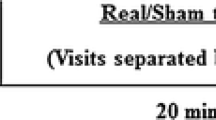Abstract
Transcranial pulsed current stimulation (tPCS) is emerging as an option in the field of neuromodulation; however, little is known about its effects on cognition and behavior and its neurophysiological correlates as indexed by autonomic responses. Our aim was to identify the effects of tPCS on arithmetic processing and risk-taking behavior, and to further categorize physiological autonomic responses by heart rate variability (HRV) and electrodermal activity measurements before, during, and after exposure to task performance and stimulation. Thirty healthy volunteers were randomized to receive a single session of sham or active stimulation with a current intensity of 2 mA and a random frequency between 1 and 5 Hz. Our results showed that tPCS has a modest and specific effect on cognitive performance as indexed by the cognitive tasks chosen in this study. There was a modest effect of active tPCS only on performance facilitation on a complex-level mathematical task as compared to sham stimulation. On autonomic responses, we observed that HRV total power increased while LF/HF ratio decreased in the tPCS active group compared to sham. There were no group differences for adverse effects. Based on our results, we conclude that tPCS, in healthy subjects, has a modest and specific cognitive effect as shown by the facilitation of arithmetical processing on complex mathematical task. These effects are accompanied by modulation of the central autonomic network providing sympathetic–vagal balance during stressful conditions. Although behavioral results were modest, they contribute to the understanding of tPCS effects and cognitive enhancement.






Similar content being viewed by others
References
Belleville S, Clement F, Mellah S, Gilbert B, Fontaine F, Gauthier S (2011) Training-related brain plasticity in subjects at risk of developing Alzheimer’s disease. Brain J Neurol 134:1623–1634. doi:10.1093/brain/awr037
Cai L, Chan JS, Yan JH, Peng K (2014) Brain plasticity and motor practice in cognitive aging. Frontiers Aging Neurosci 6:31. doi:10.3389/fnagi.2014.00031
Castillo Saavedra L et al (2014) QEEG indexed frontal connectivity effects of transcranial pulsed current stimulation (tPCS): a sham-controlled mechanistic trial. Neurosci Lett 577:61–65. doi:10.1016/j.neulet.2014.06.021
Chang C, Metzger CD, Glover GH, Duyn JH, Heinze HJ, Walter M (2013) Association between heart rate variability and fluctuations in resting-state functional connectivity. NeuroImage 68:93–104. doi:10.1016/j.neuroimage.2012.11.038
Datta A, Dmochowski JP, Guleyupoglu B, Bikson M, Fregni F (2013) Cranial electrotherapy stimulation and transcranial pulsed current stimulation: a computer based high-resolution modeling study. NeuroImage 65:280–287. doi:10.1016/j.neuroimage.2012.09.062
Demirtas-Tatlidede A, Vahabzadeh-Hagh AM, Pascual-Leone A (2013) Can noninvasive brain stimulation enhance cognition in neuropsychiatric disorders? Neuropharmacology 64:566–578. doi:10.1016/j.neuropharm.2012.06.020
Fitzgerald PB (2014) Transcranial pulsed current stimulation: a new way forward? Clinical Neurophysiol Off J Int Fed Clin Neurophysiol 125:217–219. doi:10.1016/j.clinph.2013.10.009
Gilula MF, Barach PR (2004) Cranial electrotherapy stimulation: a safe neuromedical treatment for anxiety, depression, or insomnia. South Med J 97:1269–1270
Grabner RH, Ansari D, Koschutnig K, Reishofer G, Ebner F, Neuper C (2009) To retrieve or to calculate? Left angular gyrus mediates the retrieval of arithmetic facts during problem solving. Neuropsychologia 47:604–608. doi:10.1016/j.neuropsychologia.2008.10.013
Hansen AL, Johnsen BH, Thayer JF (2003) Vagal influence on working memory and attention. Int J Psychophysiol 48:263–274
Hauser W, Bartram-Wunn E, Bartram C, Tolle TR (2011) Placebo responders in randomized controlled drug trials of fibromyalgia syndrome: systematic review and meta-analysis. Schmerz 25:619–631. doi:10.1007/s00482-011-1106-4
Kirsch DL, Smith RB (2000) The use of cranial electrotherapy stimulation in the management of chronic pain: a review. NeuroRehabilitation 14:85–94
Lichtbroun AS, Raicer MM, Smith RB (2001) The treatment of fibromyalgia with cranial electrotherapy stimulation. J Clin Rheumatol Pract Rep Rheum Musculoskelet Dis 7:72–78 discussion 78
Morales-Quezada L, Saavedra LC, Rozisky J, Hadlington L, Fregni F (2014) Intensity-dependent effects of transcranial pulsed current stimulation on interhemispheric connectivity: a high-resolution qEEG, sham-controlled study. NeuroReport 25:1054–1058. doi:10.1097/WNR.0000000000000228
Nunez PL, Wingeier BM, Silberstein RB (2001) Spatial-temporal structures of human alpha rhythms: theory, microcurrent sources, multiscale measurements, and global binding of local networks. Hum Brain Mapp 13:125–164
Park G, Thayer JF (2014) From the heart to the mind: cardiac vagal tone modulates top-down and bottom-up visual perception and attention to emotional stimuli. Front Psychol 5:278. doi:10.3389/fpsyg.2014.00278
Reyes del Paso GA, Langewitz W, Mulder LJ, van Roon A, Duschek S (2013) The utility of low frequency heart rate variability as an index of sympathetic cardiac tone: a review with emphasis on a reanalysis of previous studies. Psychophysiology 50:477–487. doi:10.1111/psyp.12027
Schutter DJLG, Leitner C, Kenemans JL, Honk JV (2006) Electrophysiological correlates of cortico-subcortical interaction: a cross-frequency spectral EEG analysis. Clin Neurophysiol 117:381–387
Studer B, Pedroni A, Rieskamp J (2013) Predicting risk-taking behavior from prefrontal resting-state activity and personality. PLoS one 8:e76861. doi:10.1371/journal.pone.0076861
Task Force of the European Society of Cardiology and the North American Society of Pacing and Electrophysiology (1996) Heart rate variability. Standards of measurement, physiological interpretation, and clinical use. Eur Heart J 17:354–381
Vallar G, Bolognini N (2011) Behavioural facilitation following brain stimulation: implications for neurorehabilitation. Neuropsychol Rehabil 21:618–649. doi:10.1080/09602011.2011.574050
Venkatakrishnan A, Sandrini M (2012) Combining transcranial direct current stimulation and neuroimaging: novel insights in understanding neuroplasticity. J Neurophysiol 107:1–4. doi:10.1152/jn.00557.2011
Wingfield A, Grossman M (2006) Language and the aging brain: patterns of neural compensation revealed by functional brain imaging. J Neurophysiol 96:2830–2839. doi:10.1152/jn.00628.2006
Acknowledgments
This research was supported in part by a grant from BrainGear Inc. LMQ appreciates the mentoring support offered by Dr. Lee Hadlington and Dr. Mark Scase from De Montfort University.
Conflict of interest
None declared.
Author information
Authors and Affiliations
Corresponding author
Additional information
Leon Morales-Quezada and Camila Cosmo are the equally contributing first authors.
Rights and permissions
About this article
Cite this article
Morales-Quezada, L., Cosmo, C., Carvalho, S. et al. Cognitive effects and autonomic responses to transcranial pulsed current stimulation. Exp Brain Res 233, 701–709 (2015). https://doi.org/10.1007/s00221-014-4147-y
Received:
Accepted:
Published:
Issue Date:
DOI: https://doi.org/10.1007/s00221-014-4147-y




